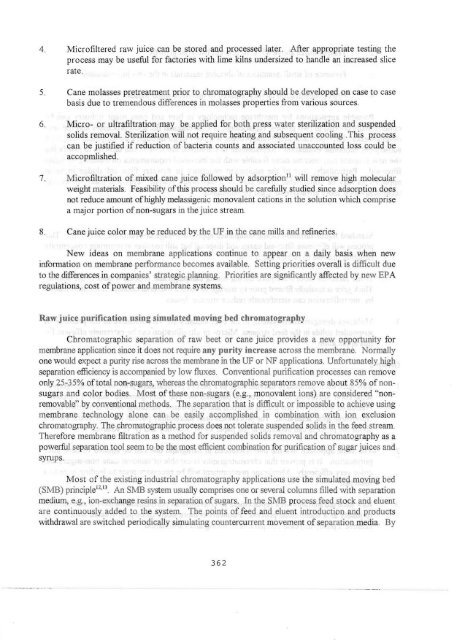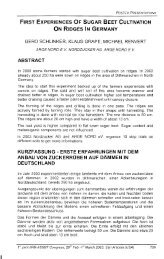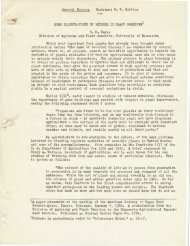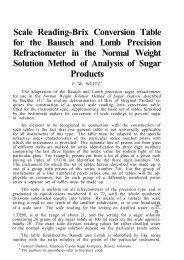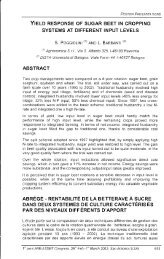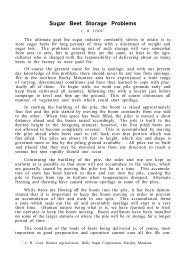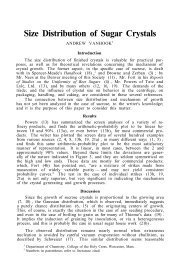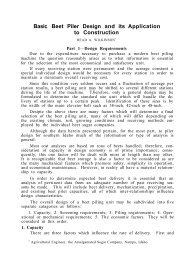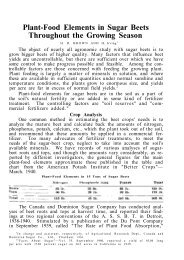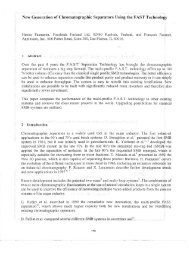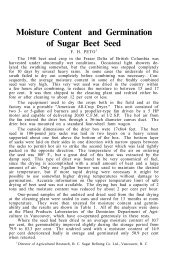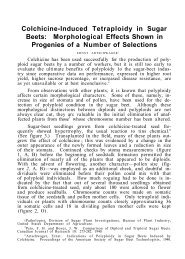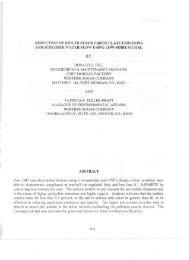membrane filtration of various sugar solutions - ASSBT Proceedings
membrane filtration of various sugar solutions - ASSBT Proceedings
membrane filtration of various sugar solutions - ASSBT Proceedings
Create successful ePaper yourself
Turn your PDF publications into a flip-book with our unique Google optimized e-Paper software.
4. Micr<strong>of</strong>iltered raw juice can be stored and processed later. After appropriate testing the<br />
process may be useful for factories with lime kilns undersized to handle an increased slice<br />
rate.<br />
5. Cane molasses pretreatment prior to chromatography should be developed on case to case<br />
basis due to tremendous differences in molasses properties from <strong>various</strong> sources.<br />
6. Micro- or ultra<strong>filtration</strong> may be applied fo r both press water sterilization and suspended<br />
solids removal. Sterjlization will not require heating and subsequent cooling. This process<br />
can be justified if reduction <strong>of</strong> bacteria counts and associated unaccounted loss could be<br />
accopmlished.<br />
7. Micro<strong>filtration</strong> <strong>of</strong> mixed cane juice followed by adsorptionll will remove high molecular<br />
weight materials. Feasibility <strong>of</strong> this process should be carefully studied since adsorption does<br />
not reduce amount <strong>of</strong>highly melassigenic monova.lent cations in the solution which comprise<br />
a major portion <strong>of</strong> non-<strong>sugar</strong>s in the juice stream.<br />
8. Cane juice color may be reduced by the UF in the cane mills and refineries.<br />
New ideas on <strong>membrane</strong> applications continue to appear on a daily basis when new<br />
infonnation on <strong>membrane</strong> performance becomes available. Setting priorities overall is difficult due<br />
to the differences in companies' strategic planning. Priorities are signillcantly affected by new EPA<br />
regulations, cost <strong>of</strong> power and <strong>membrane</strong> systems.<br />
Raw juice purification using simuJated moving bed chromatography<br />
Chromatographic separation <strong>of</strong> raw beet or cane juice provides a new opportunity for<br />
<strong>membrane</strong> application since it does not require any purity increase across the <strong>membrane</strong>. Normally<br />
one would expect a purity rise across the <strong>membrane</strong> in the UF or NF applications. Unfortunately high<br />
separation efficiency is accompanied by low fluxes. Conventional purification processes can remove<br />
only 25-35% <strong>of</strong>total non-<strong>sugar</strong>s, whereas the chromatographic separators remove about 85% <strong>of</strong> non<strong>sugar</strong>s<br />
and color bodies. Most <strong>of</strong> these Don-<strong>sugar</strong>s (e.g., monovalent ions) are considered "nonremovable"<br />
by conventional methods. The separation that is difficult or impossible to achieve using<br />
<strong>membrane</strong> technology alone can be easily accomplished in combination with ion exclusion<br />
chromatography. The chromatographic process does not tolerate suspended solids in the feed stream.<br />
Therefore <strong>membrane</strong> fiitration as a method fo r suspended solids removal and chromatography as a<br />
powerfuJ separation tooL seem to be the most efficient combination for purification <strong>of</strong> <strong>sugar</strong> juices and<br />
syrups.<br />
Most <strong>of</strong> the existing industrial chromatography applications use the simulated moving bed<br />
(SMB) principle l 2, 13 An 5MB system usually comprises one or several columns filled with separation<br />
medium, e.g. ion-exchange resins in separation <strong>of</strong><strong>sugar</strong>s. In the SlVIB process feed stock and eluent<br />
are continuously added to the system. The points <strong>of</strong> feed and eluent introduction and products<br />
withdrawal are switched periodically simulating countercurrent movement <strong>of</strong> separation media. By<br />
362


